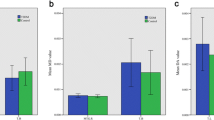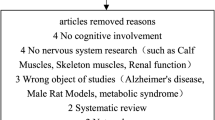Abstract
Objectives
To investigate brain microstructural changes in white matter and gray matter of type 2 diabetes mellitus (T2DM) patients using diffusion kurtosis imaging.
Methods
Diffusion kurtosis imaging (b values = 0, 1250, and 2500 s/mm2) was performed for 30 T2DM patients and 28 controls. FMRIB Software Library with tract-based spatial statistics was used to analyze intergroup differences in fractional anisotropy (FA), mean diffusivity (MD), mean kurtosis (MK), axial kurtosis (K∥), and radial kurtosis (K⊥) of multiple white matter regions. Atlas-based ROI analysis was conducted in gray matter structures and some fiber tracts. Correlations between MK changes and clinical measurements were determined.
Results
In whole-brain tract-based spatial statistics analysis, T2DM patients exhibited abnormalities in 29.6%, 30.4%, 35.4%, 10.5%, and 26.0% of white matter regions as measured by FA, MD, MK, K∥, and K⊥, respectively, when compared to the controls. MK reduction was contributed more by the decreased K⊥. In atlas-based analysis, MK detected more ROIs (27/48) with white matter microstructural changes than FA (13/48) and MD (17/48). MK decreased in bilateral thalamus and caudate, while FA showed statistically significant difference only in the left caudate. MK values negatively correlated with disease duration in the genu of corpus callosum and anterior corona radiata (R = -0.512 and -0.459) and positively correlated with neuropsychological scores in the cingulum (hippocampus) (R = 0.466 and 0.440).
Conclusions
Diffusion kurtosis imaging detects more brain regions with white matter and gray matter microstructural alterations of T2DM patients than DTI metrics. It provides valuable information for studying the pathology of diabetic encephalopathy and may lead to better imaging biomarkers for monitoring disease progression.
Key Points
• Diffusion kurtosis imaging detects more brain regions with microstructural alterations in white matter and gray matter of T2DM patients than DTI.
• Mean kurtosis changes are associated with disease severity and impaired neuropsychological function in T2DM.
• Diffusion kurtosis imaging demonstrates potential to assess cognitive impairment in T2DM patients and predict disease progression.






Similar content being viewed by others
Abbreviations
- DKI:
-
Diffusion kurtosis imaging
- DTI:
-
Diffusion tensor imaging
- FA:
-
Fractional anisotropy
- FSL:
-
Version 5.0 FMRIB Software Library
- HbA1c:
-
Glycosylated hemoglobin A1c
- HC:
-
Healthy control
- MK:
-
Mean kurtosis
- MMSE:
-
Mini-Mental State Examination
- MoCA:
-
Montreal Cognitive Assessment
- ROI:
-
Region of interest
- T2DM:
-
Type 2 diabetes mellitus
- TBSS:
-
Tract-based spatial statistics
References
Guariguata L, Whiting DR, Hambleton I, Beagley J, Linnenkamp U, Shaw JE (2014) Global estimates of diabetes prevalence in adults for 2013 and projections for 2035. Diabetes Res Clin Pract 103:137–149
Brundel M, Kappelle LJ, Biessels GJ (2014) Brain imaging in type 2 diabetes. Eur Neuropsychopharmacol 24:1967–1981
Strachan MW, Price JF, Frier BM (2008) Diabetes, cognitive impairment, and dementia. BMJ 336(7634):6
Cui Y, Jiao Y, Chen YC et al (2014) Altered spontaneous brain activity in type 2 diabetes: a resting-state functional MRI study. Diabetes 63:749–760
Cui Y, Jiao Y, Chen HJ et al (2015) Aberrant functional connectivity of default-mode network in type 2 diabetes patients. Eur Radiol 25:3238–3246
Chen YC, Xia W, Qian C, Ding J, Ju S, Teng GJ (2015) Thalamic resting-state functional connectivity: disruption in patients with type 2 diabetes. Metab Brain Dis 30:1227–1236
Moran C, Phan TG, Chen J et al (2013) Brain atrophy in type 2 diabetes: regional distribution and influence on cognition. Diabetes Care 36:4036–4042
Wu G, Lin L, Zhang Q, Wu J (2017) Brain gray matter changes in type 2 diabetes mellitus: a meta-analysis of whole-brain voxel-based morphometry study. J Diabetes Complications 31:1698–1703
Jongen C, van der Grond J, Kappelle LJ et al (2007) Automated measurement of brain and white matter lesion volume in type 2 diabetes mellitus. Diabetologia 50:1509–1516
Yang S, Ajilore O, Wu M, Lamar M, Kumar A (2015) Impaired macromolecular protein pools in fronto-striato-thalamic circuits in type 2 diabetes revealed by magnetization transfer imaging. Diabetes 64:183–192
Le Bihan D, Mangin JF, Poupon C et al (2001) Diffusion tensor imaging: concepts and applications. J Magn Reson Imaging 13:534–546
Hsu JL, Chen YL, Leu JG et al (2012) Microstructural white matter abnormalities in type 2 diabetes mellitus: a diffusion tensor imaging study. Neuroimage 59:1098–1105
Xiong Y, Sui Y, Xu Z et al (2016) A diffusion tensor imaging study on white matter abnormalities in patients with type 2 diabetes using tract-based spatial statistics. AJNR Am J Neuroradiol 37:1462–1469
Zhang J, Wang Y, Wang J et al (2014) White matter integrity disruptions associated with cognitive impairments in type 2 diabetic patients. Diabetes 63:3596–3605
Hui ES, Cheung MM, Qi L, Wu EX (2008) Towards better MR characterization of neural tissues using directional diffusion kurtosis analysis. Neuroimage 42:122–134
Steven AJ, Zhuo J, Melhem ER (2014) Diffusion kurtosis imaging: an emerging technique for evaluating the microstructural environment of the brain. AJR Am J Roentgenol 202:W26–W33
Jensen JH, Helpern JA, Ramani A, Lu H, Kaczynski K (2005) Diffusional kurtosis imaging: the quantification of non-Gaussian water diffusion by means of magnetic resonance imaging. Magn Reson Med 53:1432–1440
Cheung MM, Hui ES, Chan KC, Helpern JA, Qi L, Wu EX (2009) Does diffusion kurtosis imaging lead to better neural tissue characterization? A rodent brain maturation study. Neuroimage 45:386–392
Lazar M, Jensen JH, Xuan L, Helpern JA (2008) Estimation of the orientation distribution function from diffusional kurtosis imaging. Magn Reson Med 60:774–781
Wang JJ, Lin WY, Lu CS et al (2011) Parkinson disease: diagnostic utility of diffusion kurtosis imaging. Radiology 261:210–217
Kamagata K, Tomiyama H, Hatano T et al (2014) A preliminary diffusional kurtosis imaging study of Parkinson disease: comparison with conventional diffusion tensor imaging. Neuroradiology 56:251–258
Gong NJ, Chan CC, Leung LM, Wong CS, Dibb R, Liu C (2017) Differential microstructural and morphological abnormalities in mild cognitive impairment and Alzheimer’s disease: evidence from cortical and deep gray matter. Hum Brain Mapp 38:2495–2508
Falangola MF, Jensen JH, Tabesh A et al (2013) Non-Gaussian diffusion MRI assessment of brain microstructure in mild cognitive impairment and Alzheimer’s disease. Magn Reson Imaging 31:840–846
American Diabetes Association (2013) Diagnosis and classification of diabetes mellitus. Diabetes Care 36(Suppl 1):S67–S74
Tabesh A, Jensen JH, Ardekani BA, Helpern JA (2011) Estimation of tensors and tensor-derived measures in diffusional kurtosis imaging. Magn Reson Med 65(3):823–836
Jenkinson M, Beckmann CF, Behrens TEJ, Woolrich MW, Smith SM (2012) FSL. Neuroimage 62:782–790
Smith SM, Johansen-Berg H, Jenkinson M et al (2007) Acquisition and voxelwise analysis of multi-subject diffusion data with tract-based spatial statistics. Nat Protoc 2:499–503
Xie Y, Zhang Y, Qin W, Lu S, Ni C, Zhang Q (2017) White matter microstructural abnormalities in type 2 diabetes mellitus: a diffusional kurtosis imaging analysis. AJNR Am J Neuroradiol 38:617–625
Jensen JH, Helpern JA (2010) MRI quantification of non-Gaussian water diffusion by kurtosis analysis. NMR Biomed 23:698–710
Le Bihan D (2013) Apparent diffusion coefficient and beyond: what diffusion MR imaging can tell us about tissue structure. Radiology 268:318–322
Zhang A, Ajilore O, Zhan L et al (2013) White matter tract integrity of anterior limb of internal capsule in major depression and type 2 diabetes. Neuropsychopharmacology 38:1451–1459
Frøkjær JB, Andersen LW, Brock C et al (2013) Altered brain microstructure assessed by diffusion tensor imaging in patients with diabetes and gastrointestinal symptoms. Diabetes Care 36:662–668
Hoogenboom WS, Marder TJ, Flores VL et al (2014) Cerebral white matter integrity and resting-state functional connectivity in middle-aged patients with type 2 diabetes. Diabetes 63:728–738
Reijmer YD, Brundel M, de Bresser J et al (2013) Microstructural white matter abnormalities and cognitive functioning in type 2 diabetes: a diffusion tensor imaging study. Diabetes Care 36:137–144
Wu EX, Cheung MM (2010) MR diffusion kurtosis imaging for neural tissue characterization. NMR Biomed 23:836–848
Raab P, Hattingen E, Franz K, Zanella FE, Lanfermann H (2010) Cerebral gliomas: diffusional kurtosis imaging analysis of microstructural differences. Radiology 254:876–881
Wu WC, Yang SC, Chen YF, Tseng HM, My PC (2017) Simultaneous assessment of cerebral blood volume and diffusion heterogeneity using hybrid IVIM and DK MR imaging: initial experience with brain tumors. Eur Radiol 27:306–314
Grossman EJ, Ge Y, Jensen JH et al (2012) Thalamus and cognitive impairment in mild traumatic brain injury: a diffusional kurtosis imaging study. J Neurotrauma 29:2318–2327
Gao J, Feng ST, Wu B et al (2015) Microstructural brain abnormalities of children of idiopathic generalized epilepsy with generalized tonic-clonic seizure: a voxel-based diffusional kurtosis imaging study. J Magn Reson Imaging 41:1088–1095
Sun Y, Sun J, Zhou Y et al (2014) Assessment of in vivo microstructure alterations in gray matter using DKI in internet gaming addiction. Behav Brain Funct 10:37
Lee CY, Bennett KM, Debbins JP (2013) Sensitivities of statistical distribution model and diffusion kurtosis model in varying microstructural environments: a Monte Carlo study. J Magn Reson 230:19–26
Steriade M, Llinás RR (1988) The functional states of the thalamus and the associated neuronal interplay. Physiol Rev 68:649–742
Carlesimo GA, Lombardi MG, Caltagirone C (2011) Vascular thalamic amnesia: a reappraisal. Neuropsychologia 49:777–789
Hintzen A, Pelzer EA, Tittgemeyer M (2018) Thalamic interactions of cerebellum and basal ganglia. Brain Struct Funct 223:569–587
Tachibana Y, Obata T, Tsuchiya H et al (2016) Diffusion-tensor-based method for robust and practical estimation of axial and radial diffusional kurtosis. Eur Radiol 26:2559–2566
Funding
This study has received funding by the National Natural Science Foundation of China (grant numbers 81601480, 81471230, and 81171308).
Author information
Authors and Affiliations
Corresponding authors
Ethics declarations
Guarantor
The scientific guarantor of this publication is Wenzhen Zhu.
Conflict of interest
The authors declare that they have no conflict of interest.
Statistics and biometry
No complex statistical methods were necessary for this paper.
Informed consent
Written informed consent was obtained from all subjects in this study.
Ethical approval
Institutional Review Board approval was obtained.
Study subjects or cohorts overlap
Some study subjects or cohorts have been previously reported in part at the 101st Annual Meeting of the Radiological Society of North America, Chicago, USA, 25–30 November 2015.
Methodology
• prospective
• diagnostic or prognostic study
• performed at one institution
Rights and permissions
About this article
Cite this article
Xiong, Y., Sui, Y., Zhang, S. et al. Brain microstructural alterations in type 2 diabetes: diffusion kurtosis imaging provides added value to diffusion tensor imaging. Eur Radiol 29, 1997–2008 (2019). https://doi.org/10.1007/s00330-018-5746-y
Received:
Revised:
Accepted:
Published:
Issue Date:
DOI: https://doi.org/10.1007/s00330-018-5746-y




